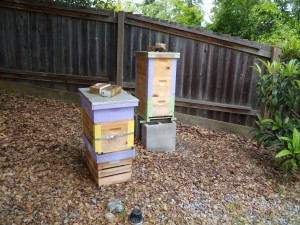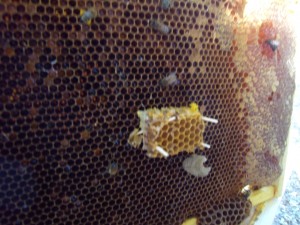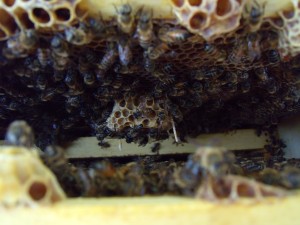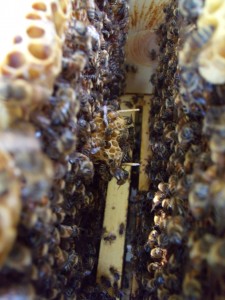Without further ado…
The first split
On April 26th, I inspected the first beehive split (christened Blazer—as in trail blazer) and her mother hive, Hortensia. The mother hive was full of both capped and uncapped brood (yay!!!), but Blazer still had nothing. I selected a frame of eggs from Hortensia and placed it beside a frame of pollen and nectar in the split.
I returned on May 2nd and found that the bees were in the process of building a queen cell. It wasn’t yet capped, but I have to say that it looked kind of ‘puny’ to me. The split has plenty of bees (about five drawn frames covered in bees) and plenty of pollen and nectar stores. We will check for signs of a laying queen toward the end of May. If the split appears queenless at that time, we will recombine it with Hortensia.
The second split
I inspected both the split (Em) and the mother hive (May) on April 27th. The split was going gangbusters, with lots of uncapped brood and a plump new queen that I glimpsed running away from me down between two frames.
May had no brood in any of its three boxes, and the bees seemed disorganized and aimless. There were, however, still lots of bees in the mother hive. I returned to the split and removed a frame of eggs and young brood. I used an X-Acto knife to cut out a swatch of comb measuring approximately one by one-and-a-half inches. I specifically selected comb where I only saw eggs.
I used four toothpicks at the corners of the comb to secure it in the middle of a frame of pollen and nectar in the mother hive. I made sure that this frame was facing another frame of nectar and pollen and that it was situated near the center of the middle box. There are plenty of additional stores in surrounding frames. I also removed one of the frames in that box to allow room for the protruding toothpicks and comb.
I returned to inspect again on May 2nd. I found that the bees had built a smallish queen cell on the upper left corner of the attached swatch of comb. Surprisingly, the cell was already capped. This makes me wonder if I failed to spot a small larva in amongst the eggs, and if the bees chose this to be their queen.
I fear that the small size of the cell does not bode well for the queen’s viability. The small size may be due to the fact that older bees (the only bees left in this hive after more than a month without a queen) are not as good at feeding brood. Older worker bees can revert to acting as nurse bees in cases of emergency, but they may not be able to produce the same quality or quantity of royal jelly, the food required by queen bees throughout their larval stage and through their adult lives.
On the bright side, I did see a lot of activity on the frame with the queen cell, and a number of bees were covering the cell and moving around it.
As with the first split, if May’s second attempt at queen rearing doesn’t pan out by the end of this month, we will recombine the hives.
Conclusion
Why did one split and one mother hive fail to raise viable queens on their first attempts? In both cases, the mother hives had capped queen cells when I performed the splits. It’s possible that I jarred some of these cells, causing the unborn queens to fall to the bottoms of their cells and stopping their wings from properly developing. In this case, the young queens would not have been able to venture out for their mating flights.
On the other hand, I found no signs of queens that had become drone layers (this is often the case when a virgin queen is unable to properly mate). Maybe it is more likely that the queens perished on their mating flights. We had some extremely windy days in April, and there is also always the possibility of a queen being eaten by a bird when she leaves the hive.
Whatever the reason(s), we are keeping our fingers crossed for better results when the new queen cells hatch.






2 Responses to Hive Split Update